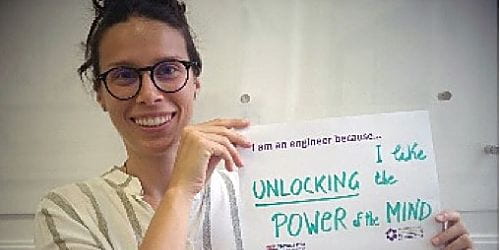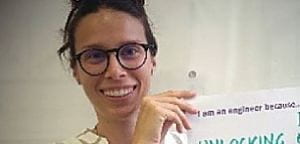Building bridges to a fairer future
Our teaching staff are passionate about passing knowledge and expertise on to the next generation. We’re equally keen to encourage more women into engineering careers.

We talked to Dr Maria Pregnolato, a lecturer in civil engineering and research fellow. She is funded by the Engineering and Physical Sciences Research Council (EPSRC) and dedicates most of her time to researching flood risk and impact, currently focussing on bridges in flood-prone areas.
Did your early years point to a career in engineering, for example a favourite toy or subjects at school?
My favourite toy during my childhood was undoubtedly Lego but I’d find it hard to pick just one subject at school. I honestly liked most of them, from Italian literature and history to maths and chemistry. School was fun for me. If I had to choose, it’d be a combination of Italian literature and geometry, a kind of poetry in the theorems!
Did you study for a degree, what course, where and why?
Expand your knowledge
I took a five-year BSc plus MSc programme in Building Engineering-Architecture. I studied at the University of Pavia in Italy and at the Tongji University of Shanghai in China. I chose the course because I wanted a multi-disciplinarily degree and to complete it in English. After that, I moved to Newcastle to study for a PhD in Civil Engineering, specialising in flood risk assessment.
Which engineer has inspired you and what is your top tip for students?

I think Leonardo da Vinci was a truly magical, multi-disciplinary engineer.
My top tip is: Believe, believe, believe. And be bold. Cheryl Sandberg (Facebook Chief Operating Officer) suggested you ask yourself when you feel doubtful; what would I do if I were not afraid? You are your only limit.
Why would having more women in engineering benefit society?
A lack of diversity and the same old stereotypes are never good for progress. We need a range of perspectives and attitudes. Women think differently, care differently. Women tend to use both the left and right hemispheres of their brains, whereas men favour the left. This means women are more likely to have broader perspectives and see the bigger picture, rather than taking a solely fact-based approach.
The world needs products and services that are suitable for everyone, and that cannot happen if the designers are predominantly men. It has been proven that increasing diversity helps problem solving and enhances effectiveness in work groups. Research has also shown that organisations with a greater number of women in leadership positions are more profitable. Nowadays leadership is not based on physical strength but on the power of the mind. We need leaders who are emotionally intelligent, sympathetic and resilient. Women have all those qualities and many more.
This year’s theme for International Women in Engineering Day is ‘Shape the World’ – what would be top of your wish list for the next decade?
Gender equality is happening but the pace of change is uncertain. I hope that in ten years’ time we’ll have a more balanced world in terms of mindsets, beliefs, language, leadership and the pay gap. Can’t wait to be there!
Related research
Dr Pregnolato works with these research groups:-


